Active Equalization of Lithium-Ion Battery Based on Reconfigurable Topology
Abstract
:1. Introduction
- (1)
- : The number of cells in each battery group.
- (2)
- : The number of battery groups.
- (3)
- : The SOC of the ith cell in the battery group.
- (4)
- : The average SOC of the jth battery group.
- (5)
- : The average SOC of all the n × m battery cells.
- (6)
- : The output voltage of the ith cell in the battery group.
- (7)
- : The output voltage of the jth battery group (the input voltage of the jth DC/DC converter).
- (8)
- : The output voltage of the jth DC/DC converter.
- (9)
- : The output voltage of the battery pack.
- (10)
- : The duty cycle of the MOSFET in the jth DC/DC converter.
- (11)
- : The power coefficient of the jth battery group.
- (12)
- : The permissible SOC error limit in the battery group.
- (13)
- : The permissible SOC error limit between the battery groups.
2. Double Layer Equalization Model
2.1. Inner Layer: Reconfigurable Equalization Topology
- (1)
- At the beginning of the equalization (Figure 3a), the system collects the SOCs of all the cells in the group. The cell with the lowest SOC (cell i) is isolated (switch on S_2i − 1, switch off S_2i), and the other cells are connected in series to discharge (switch on S_2, S_4…S_2n, switch off S_1, S_3…S_2n − 1).
- (2)
- The series battery group continuously discharges until the SOC of the cell with the highest SOC in step (1) (cell 1) equals the SOC of the cell being isolated (cell i) (Figure 3b). Then the cell being isolated (cell i) is connected to the working part of the group (switch on S_2i, switch off S_2i − 1). Meanwhile, the cell with the lowest SOC at this moment (cell n) is isolated (switch on S_2n − 1, switch off S_2n).
- (3)
- The series battery group repeats steps (1) and (2) until all the SOCs are equal. (Figure 3c). At this moment, all the cells have similar SOCs, and the process of equalization in this group is over. Then all the cells are connected in series to discharge (switch on S_2n, switch off S_2n − 1).
2.2. Outer Layer: Power Distribution through Buck–Boost Converters
3. Control Strategy
3.1. Control Strategy of the Inner Layer
3.2. Control Strategy of the Outer Layer
4. Calculation and Comparison
4.1. Efficiency Calculation of the Ideal Working Circuit
4.2. Efficiency Calculation of the Conventional Equalization Circuit Based on DC/DC Converter
4.3. Efficiency Calculation of the Proposed Circuit
4.4. Comparison of Balancing Efficiency
5. Simulation Results and Discussion
5.1. Simulation Results of the Inner Layer
5.2. Simulation Results of the Outer Layer
5.3. Simulation Results of the Battery Pack
5.4. Simulation Results of the Output Voltage
6. Conclusions
- (1)
- The inner layer proposed in this paper realizes balance among cells in the same group through the reconfigurable topology. Compared with the conventional active equalization method, the proposed method uses fewer components, has lower cost, higher efficiency, and simpler control complexity. Moreover, the equalization process goes on equally well regardless of the positions the cells needed to be balanced in the group.
- (2)
- The method of connecting the outputs of converters in series is used in the outer layer. The proposed outer layer can realize the balance among battery groups and keep the output voltage and power of the system stable at the same time. It solves the problem that using the reconfigurable topology alone cannot stabilize or adjust the output voltage.
- (3)
- The efficiency of the proposed equalization method was calculated and compared with the conventional converter active equalization method. The results showed that the proposed method can improve the balancing efficiency, and the higher the unbalance of the battery system is, the more significant the improvement is. The proposed method is suitable for scenarios like retired battery energy storage systems which have high power, large capacity, and high requirements for balancing efficiency and robustness.
Author Contributions
Funding
Institutional Review Board Statement
Informed Consent Statement
Data Availability Statement
Conflicts of Interest
References
- Li, J.; Li, Y.; Lyu, C.; Zhao, W.; Zhou, J. Key Technology and Research Status of Cascaded Utilization in Decommissioned Power Battery. Autom. Electr. Power Syst. 2020, 44, 172–183. [Google Scholar]
- Wang, S. Research on Sorting and Grouping for Second-Use of Retired Battery Modules. Ph.D. Thesis, North China Electric Power University, Beijing, China, 2021. [Google Scholar]
- Dai, S.; Zhang, F.; Zhao, X. Series-connected battery equalization system: A systematic review on variables, topologies, and modular methods. Int. J. Energy Res. 2021, 45, 19709–19728. [Google Scholar] [CrossRef]
- Zhang, Y.; Huang, M.M.; Wu, T.Z.; Ji, F. Reconfigurable equilibrium circuit with additional power supply. Int. J. Low-Carbon Technol. 2020, 15, 106–111. [Google Scholar] [CrossRef] [Green Version]
- Javier, G.L.; Enrique, R.C.; Isabel, M.M.; Miguel, A.G.M. Battery equalization active methods. J. Power Sources 2014, 246, 934–949. [Google Scholar]
- Jiang, Y.; Jiang, J.C.; Zhang, C.P.; Zhang, W.G.; Gao, Y.; Guo, Q.P. Recognition of battery aging variations for LiFePO4 batteries in 2nd use applications combining incremental capacity analysis and statistical approaches. J. Power Sources 2017, 360, 180–188. [Google Scholar] [CrossRef]
- Zhou, H.; Wu, H.; Han, X.B.; Zheng, Y.J.; Yan, L.Q.; Lv, T.L.; Xie, J.Y. An expeditious and simple scheme for measuring self-discharge rate of lithium batteries. Int. J. Energy Res. 2022, 46, 15948–15960. [Google Scholar] [CrossRef]
- Zhou, L.; Zheng, Y.J.; Ouyang, M.G.; Lu, L.G. A study on parameter variation effects on battery packs for electric vehicles. J. Power Sources 2017, 364, 242–252. [Google Scholar] [CrossRef]
- Bandhauer, T.M.; Garimella, S.; Fuller, T.F. A Critical Review of Thermal Issues in Lithium-Ion Batteries. J. Electrochem. Soc. 2011, 158, R1–R25. [Google Scholar] [CrossRef]
- Hua, Y.; Zhou, S.D.; Cui, H.G.; Liu, X.H.; Zhang, C.; Xu, X.W.; Ling, H.P.; Yang, S.C. A comprehensive review on inconsistency and equalization technology of lithium-ion battery for electric vehicles. Int. J. Energy Res. 2020, 44, 11059–11087. [Google Scholar] [CrossRef]
- Seong, W.M.; Park, K.Y.; Lee, M.H.; Moon, S.; Oh, K.; Park, H.; Lee, S.; Kang, K. Abnormal self-discharge in lithium-ion batteries. Energy Environ. Sci. 2018, 11, 970–978. [Google Scholar] [CrossRef]
- McCurlie, L.; Preindl, M.; Emadi, A. Fast Model Predictive Control for Redistributive Lithium-Ion Battery Balancing. IEEE Trans. Ind. Electron. 2017, 64, 1350–1357. [Google Scholar] [CrossRef]
- Baronti, F.; Roncella, R.; Saletti, R. Performance comparison of active balancing techniques for lithium-ion batteries. J. Power Sources 2014, 267, 603–609. [Google Scholar] [CrossRef]
- Cai, M.; Zhang, E.; Lin, J.; Wang, K.; Jiang, K.; Zhou, M. Review on Balancing Topology of Lithium-ion Battery Pack. Proc. CSEE 2021, 41, 5294–5310. [Google Scholar]
- Hua, Y.; Zhou, S.; He, R.; Cui, H.; Yang, S. Review on Lithium-ion Battery Equilibrium Technology Applied for EVs. J. Mech. Eng. 2019, 55, 73–84. [Google Scholar]
- Kim, M.Y.; Kim, C.H.; Kim, J.H.; Moon, G.W. A Chain Structure of Switched Capacitor for Improved Cell Balancing Speed of Lithium-Ion Batteries. IEEE Trans. Ind. Electron. 2014, 61, 3989–3999. [Google Scholar] [CrossRef]
- Li, X.L.; Xu, S.G.; Xu, J.P.; Liu, Q.Y. Single-inductor bidirectional battery equalizer. Electr. Mach. Control 2019, 23, 90–97. [Google Scholar]
- Shang, Y.L.; Zhang, C.H.; Cui, N.X.; Mi, C.C. A Delta-Structured Switched-Capacitor Equalizer for Series-Connected Battery Strings. IEEE Trans. Power Electron. 2019, 34, 452–461. [Google Scholar]
- Shang, Y.; Xia, B.; Zhang, C.; Cui, N.; Yang, J.; Mi, C.C. An Automatic Equalizer Based on Forward–Flyback Converter for Series-Connected Battery Strings. IEEE Trans. Ind. Electron. 2017, 64, 5380–5391. [Google Scholar] [CrossRef]
- Yuanliang, F.; Yule, W.; Gang, Z.; Han, W.; Jianye, H. A novel circuit for reducing equalizing currents in reconfigurable battery packs. In Proceedings of the 2020 8th International Conference on Power Electronics Systems and Applications (PESA), Hong Kong, China, 7–10 December 2020. [Google Scholar]
- Ci, S.; Lin, N.; Wu, D.L. Reconfigurable Battery Techniques and Systems: A Survey. IEEE Access 2016, 4, 1175–1189. [Google Scholar] [CrossRef]
- Xiaoqian, W.; Bin, D.; Yunlong, S.; Yinghui, X.; Keke, Y.; Chenghui, Z. Fast Equalization for Lithium Ion Battery Packs Based on Reconfigurable Battery Structure. In Proceedings of the 2020 IEEE/IAS Industrial and Commercial Power System Asia (I&CPS Asia), Weihai, China, 13–16 July 2020; pp. 1149–1154. [Google Scholar]
- Rahman, M.A.; de Craemer, K.; Buscher, J.; Driesen, J.; Coenen, P.; Mol, C. Comparative Analysis of Reconfiguration Assisted Management of Battery Storage Systems. In Proceedings of the 45th Annual Conference of the IEEE Industrial Electronics Society, Lisbon, Portugal, 14–17 October 2019. [Google Scholar]
- Muhammad, S.; Rafique, M.U.; Li, S.; Shao, Z.L.; Wang, Q.X.; Liu, X. Reconfigurable Battery Systems: A Survey on Hardware Architecture and Research Challenges. ACM Transact. Des. Automat. Electron. Syst. 2019, 24, 27. [Google Scholar] [CrossRef]
- Meng, J.W.; Boukhnifer, M.; Diallo, D.; Wang, T.Z. Short-Circuit Fault Diagnosis and State Estimation for Li-ion Battery using Weighting Function Self-Regulating Observer. In Proceedings of the Prognostics and System Health Management Conference, Besancon, France, 4–7 May 2020. [Google Scholar]
- Xiong, R.; Sun, F.C.; Chen, Z.; He, H.W. A data-driven multi-scale extended Kalman filtering based parameter and state estimation approach of lithium-ion polymer battery in electric vehicles. Appl. Energy 2014, 113, 463–476. [Google Scholar] [CrossRef]
- Yang, F.F.; Li, W.H.; Li, C.; Miao, Q. State-of-charge estimation of lithium-ion batteries based on gated recurrent neural network. Energy 2019, 175, 66–75. [Google Scholar] [CrossRef]
- Wei, Z.B.; Zou, C.F.; Leng, F.; Soong, B.H.; Tseng, K.J. Online Model Identification and State-of-Charge Estimate for Lithium-Ion Battery With a Recursive Total Least Squares-Based Observer. IEEE Trans. Ind. Electron. 2018, 65, 1336–1346. [Google Scholar] [CrossRef]
- Feng, F.; Teng, S.L.; Liu, K.L.; Xie, J.L.; Xie, Y.; Liu, B.; Li, K.X. Co-estimation of lithium-ion battery state of charge and state of temperature based on a hybrid electrochemical-thermal-neural-network model. J. Power Sources 2020, 455, 227935. [Google Scholar] [CrossRef]
- He, L.; Kim, E.; Shin, K.G. A Case Study on Improving Capacity Delivery of Battery Packs via Reconfiguration. ACM Trans. Cyber-Phys. Syst. 2017, 1, 23. [Google Scholar] [CrossRef]
- Ji, F.; Liao, L.; Wu, T.Z.; Chang, C.; Wang, M.N. Self-reconfiguration batteries with stable voltage during the full cycle without the DC-DC converter. J. Energy Storage 2020, 28, 9. [Google Scholar] [CrossRef]
- Wu, T.Z.; Huang, Z.Y.; Lu, C.D. Research on two-level equalization method based on reconfigurable circuit. Chin. J. Power Sources 2020, 44, 1671–1674. [Google Scholar]


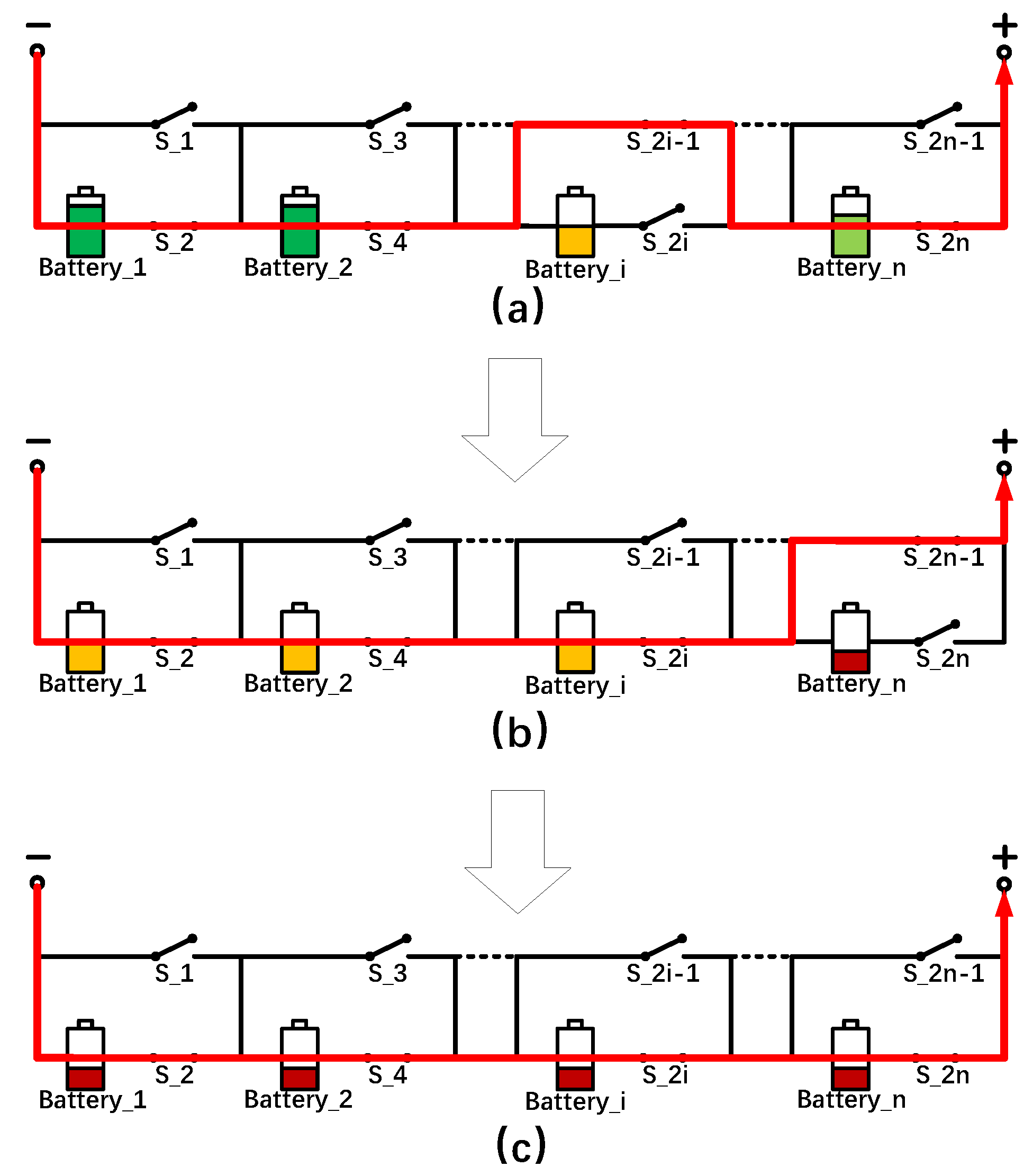

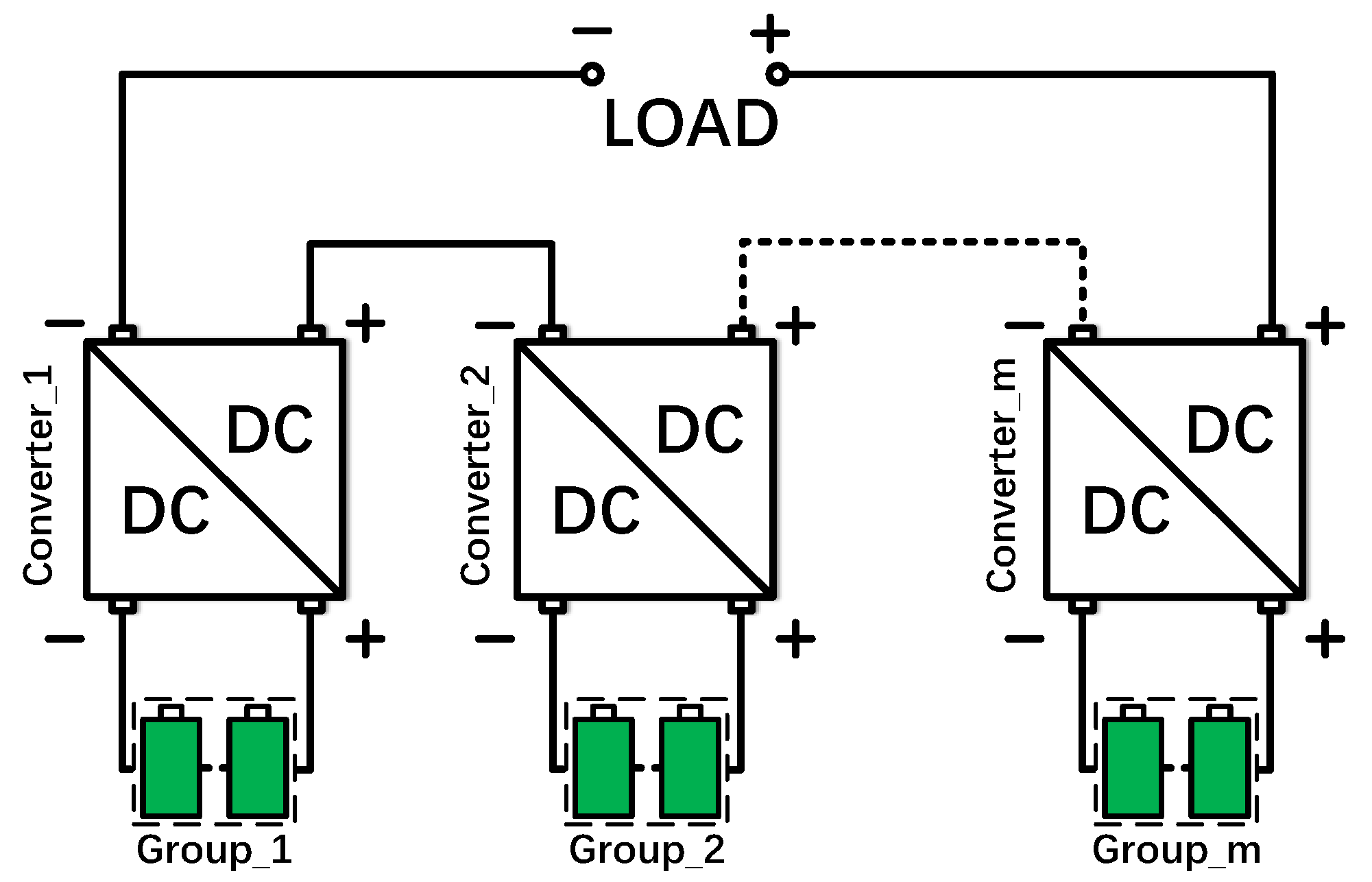
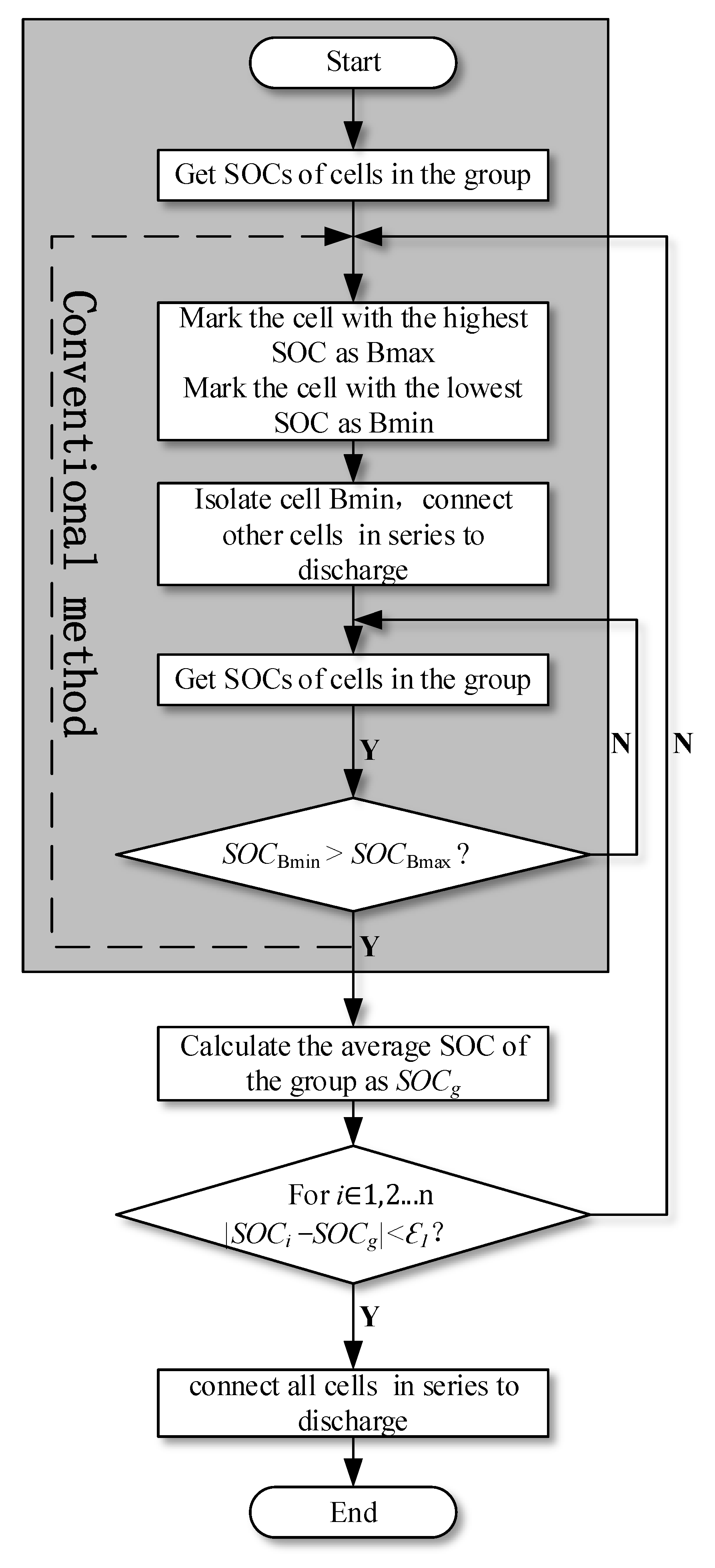
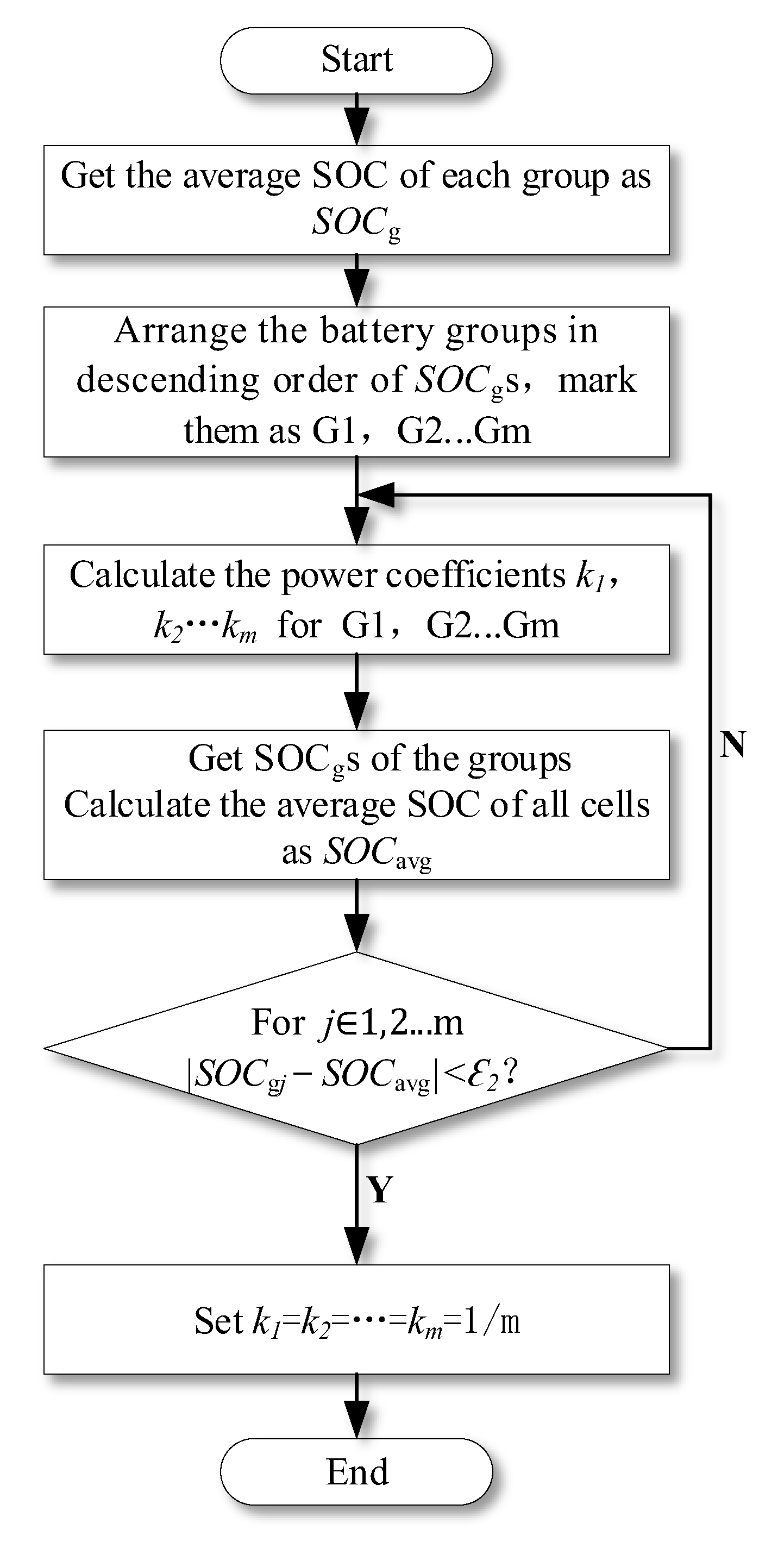

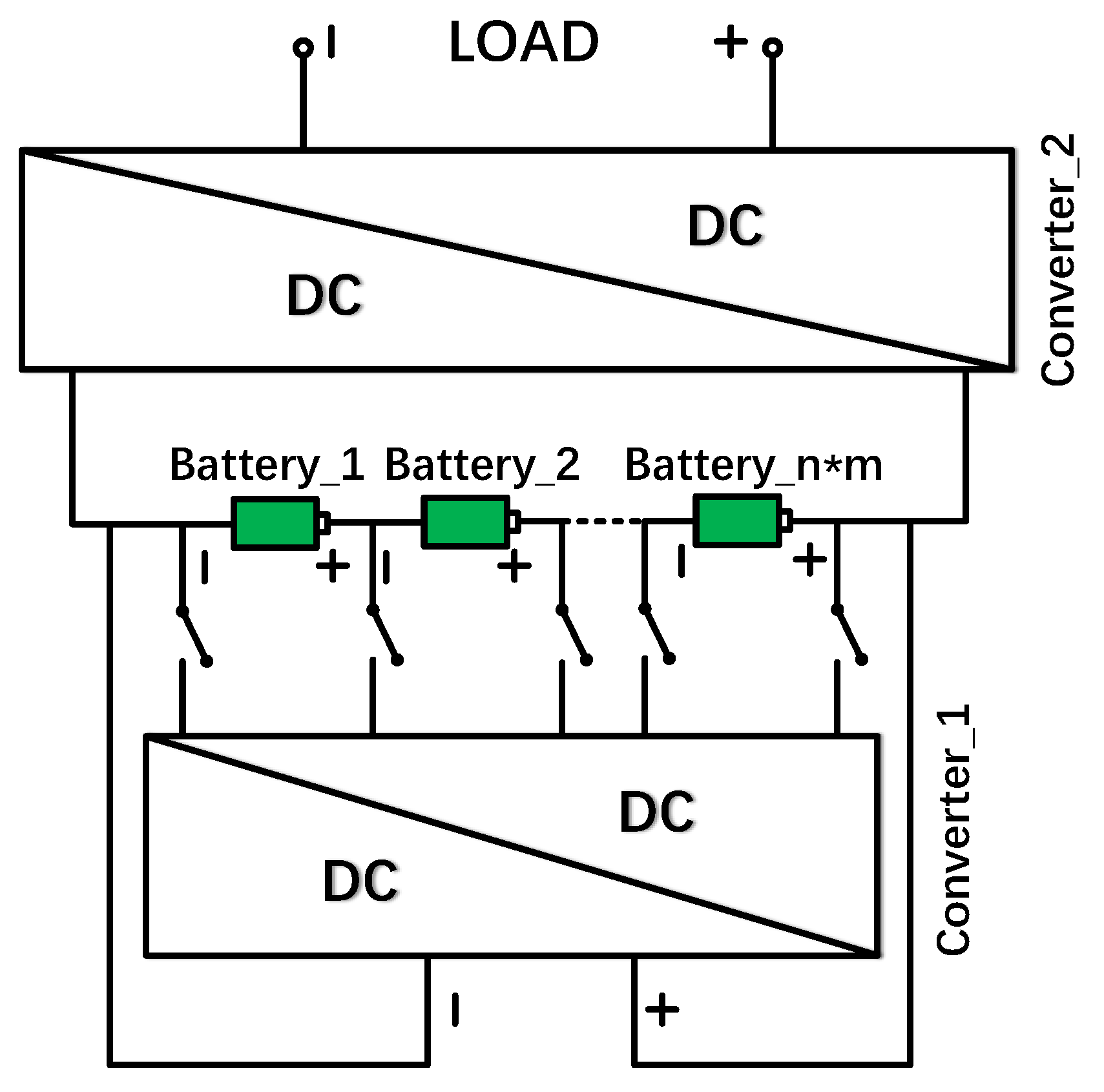
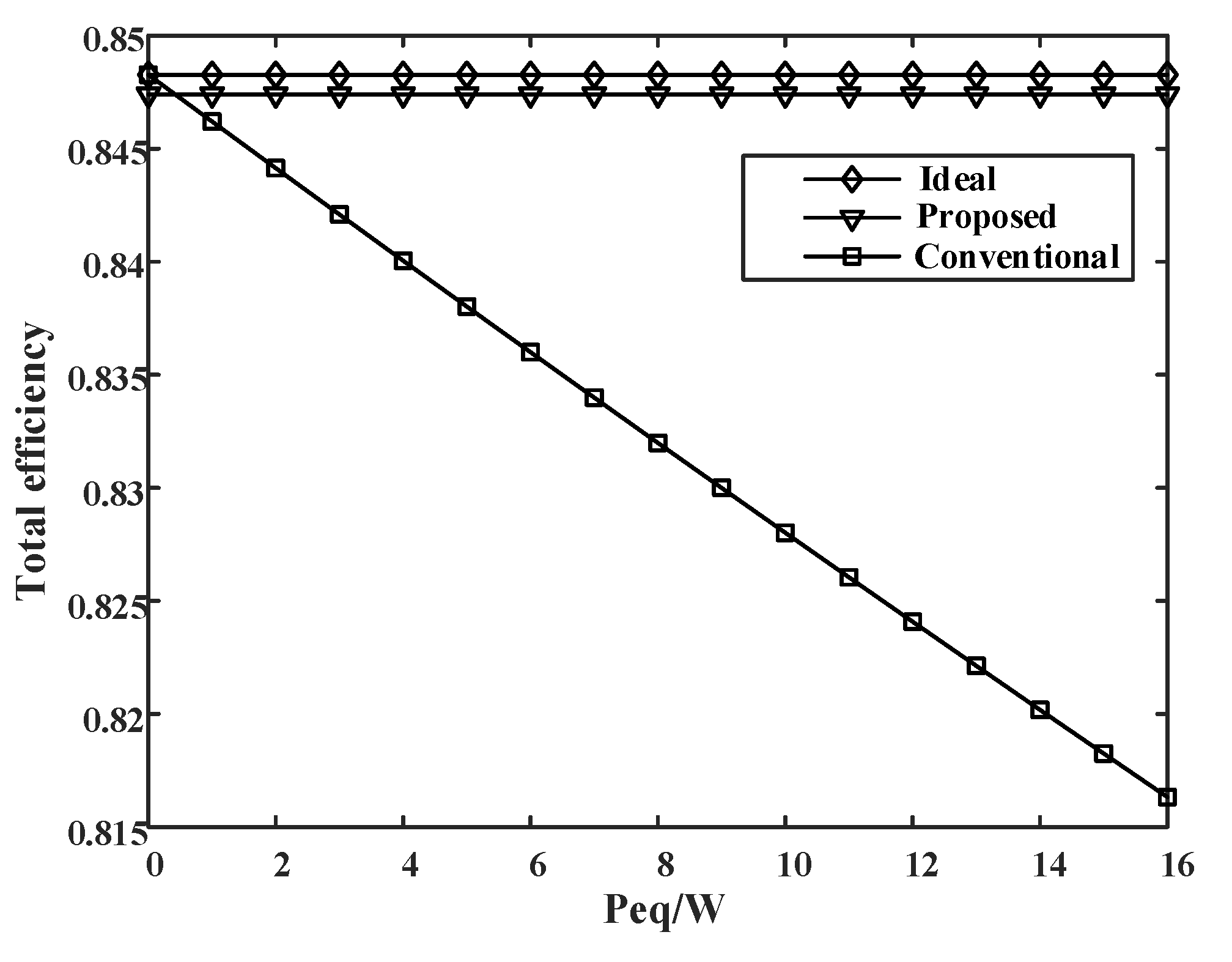
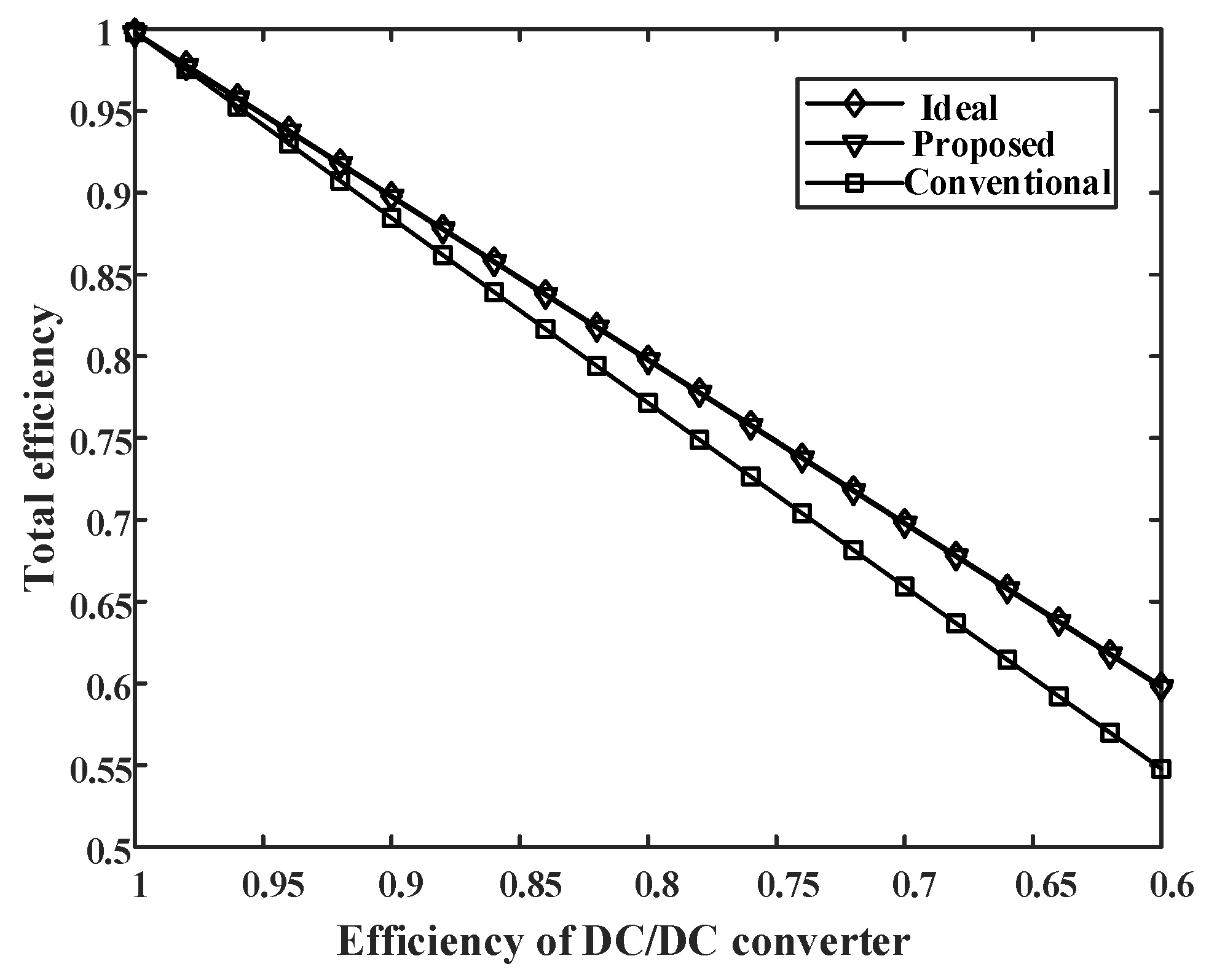
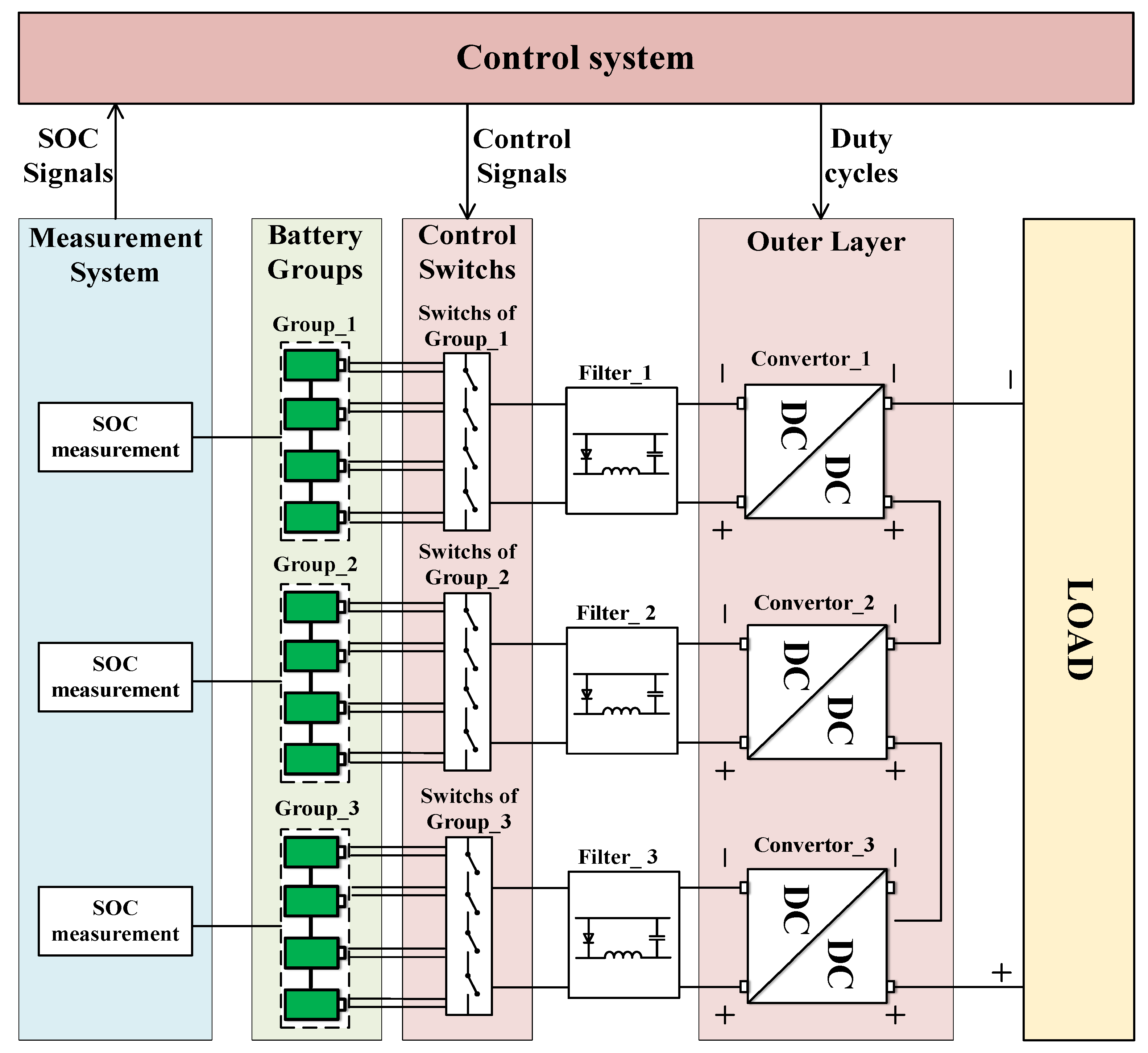
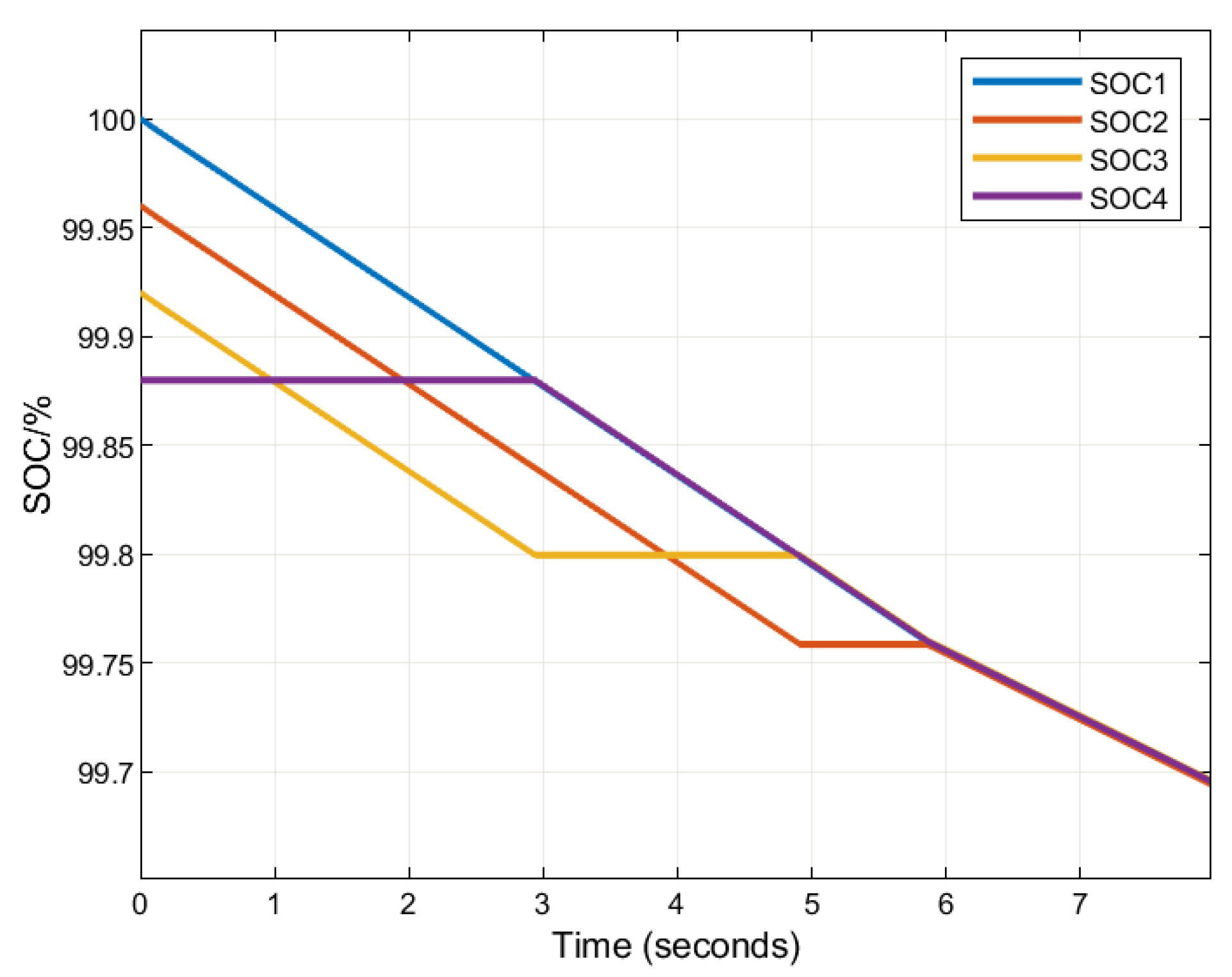
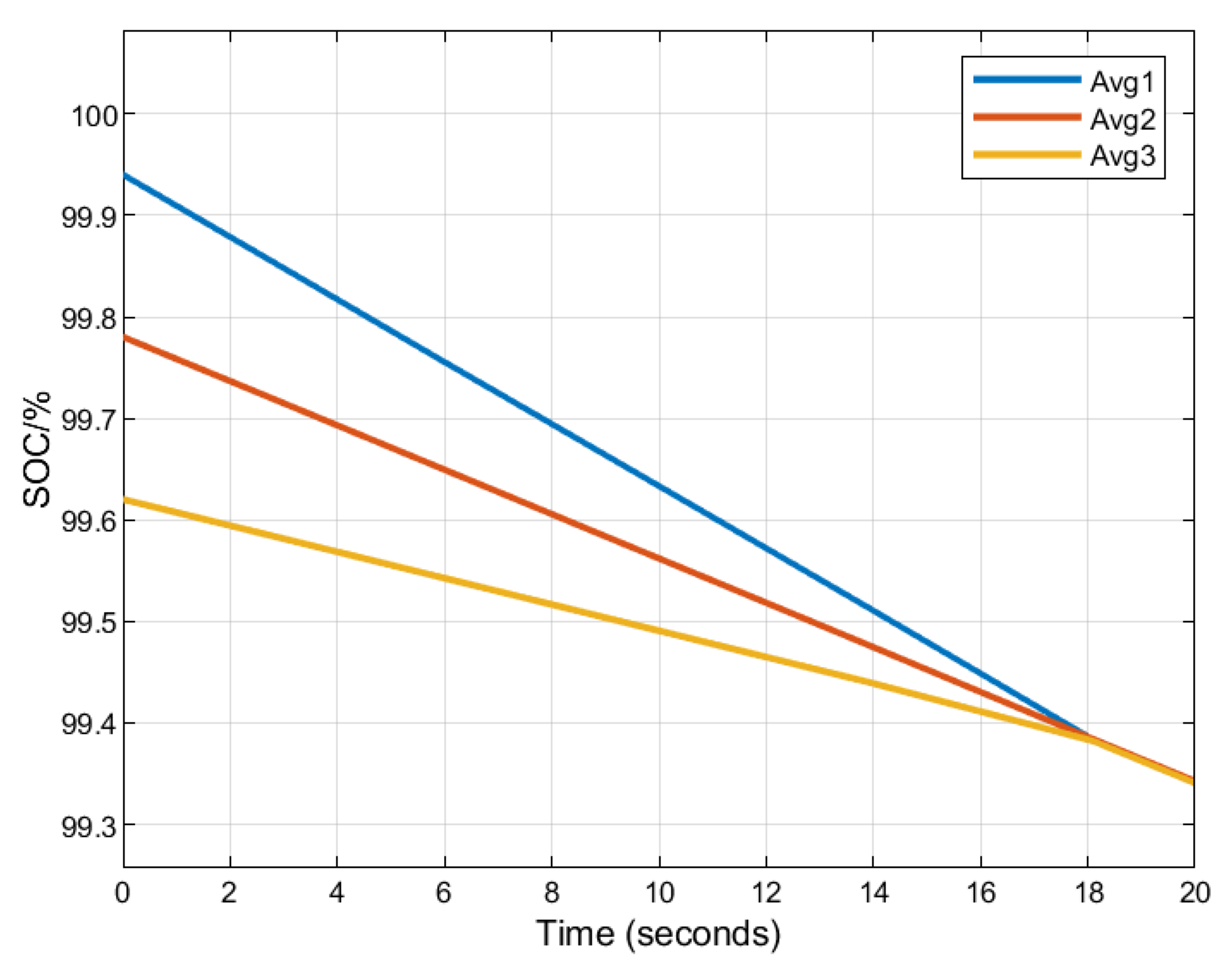


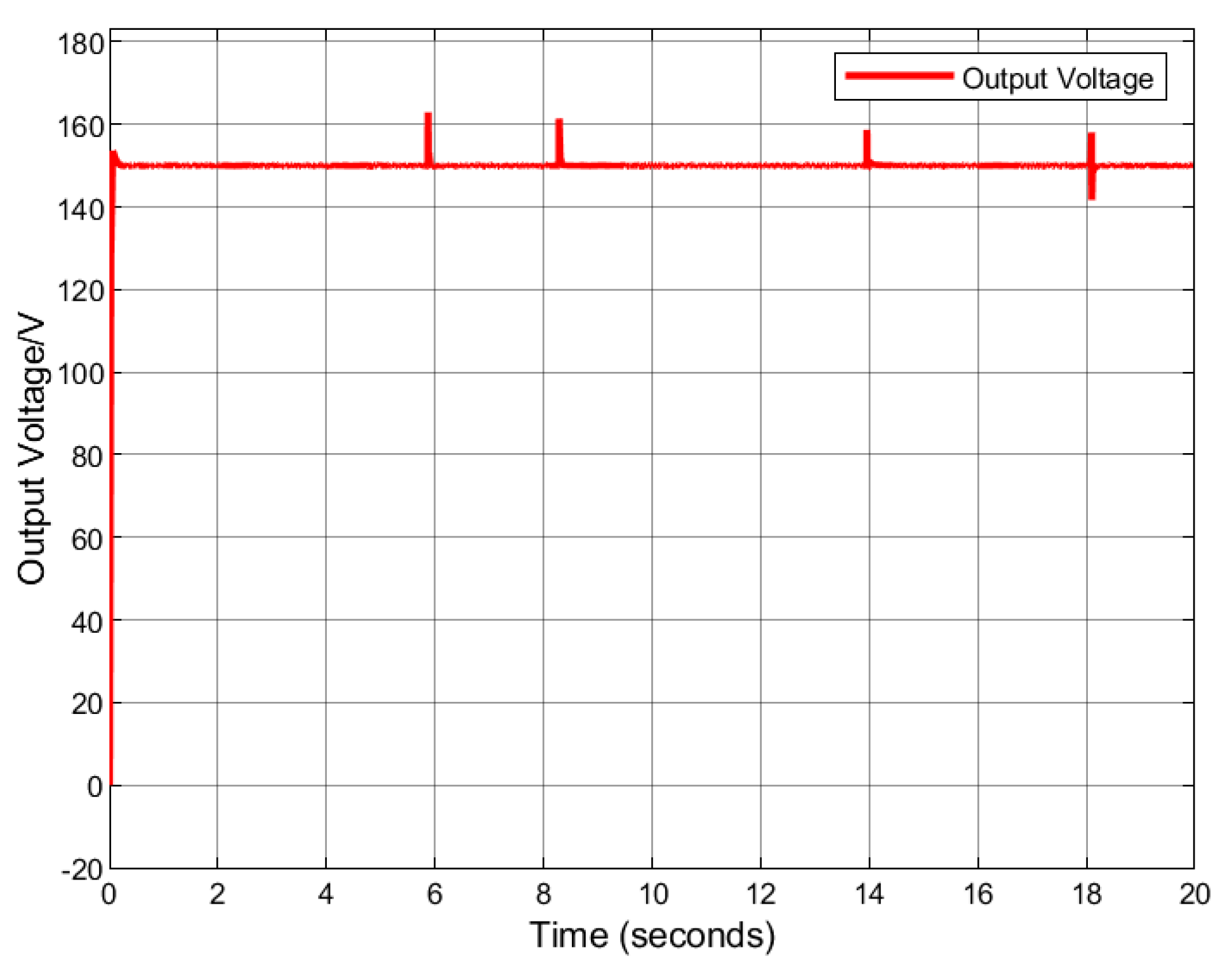
| Parameters | Value |
|---|---|
| number of battery cells | 4 × 3 |
| internal resistance of a battery cell /Ω | 0.01 |
| internal resistance of a MOSFET /Ω | 0.001 |
| output voltage of a battery cell /V | 7.2 |
| load voltage /V | 72 |
| load current /A | 1 |
| load power /W | 72 |
| equalization power /W | |
| efficiency of DC/DC converter /% |
| Cell Number | 1 | 2 | 3 | 4 | 5 | 6 | 7 | 8 | 9 | 10 | 11 | 12 |
|---|---|---|---|---|---|---|---|---|---|---|---|---|
| SOC (%) | 100 | 99.96 | 99.92 | 99.88 | 99.84 | 99.80 | 99.76 | 99.72 | 99.68 | 99.64 | 99.60 | 99.56 |
Disclaimer/Publisher’s Note: The statements, opinions and data contained in all publications are solely those of the individual author(s) and contributor(s) and not of MDPI and/or the editor(s). MDPI and/or the editor(s) disclaim responsibility for any injury to people or property resulting from any ideas, methods, instructions or products referred to in the content. |
© 2023 by the authors. Licensee MDPI, Basel, Switzerland. This article is an open access article distributed under the terms and conditions of the Creative Commons Attribution (CC BY) license (https://creativecommons.org/licenses/by/4.0/).
Share and Cite
Li, Y.; Yin, P.; Chen, J. Active Equalization of Lithium-Ion Battery Based on Reconfigurable Topology. Appl. Sci. 2023, 13, 1154. https://doi.org/10.3390/app13021154
Li Y, Yin P, Chen J. Active Equalization of Lithium-Ion Battery Based on Reconfigurable Topology. Applied Sciences. 2023; 13(2):1154. https://doi.org/10.3390/app13021154
Chicago/Turabian StyleLi, Yanbo, Pu Yin, and Junshuo Chen. 2023. "Active Equalization of Lithium-Ion Battery Based on Reconfigurable Topology" Applied Sciences 13, no. 2: 1154. https://doi.org/10.3390/app13021154




